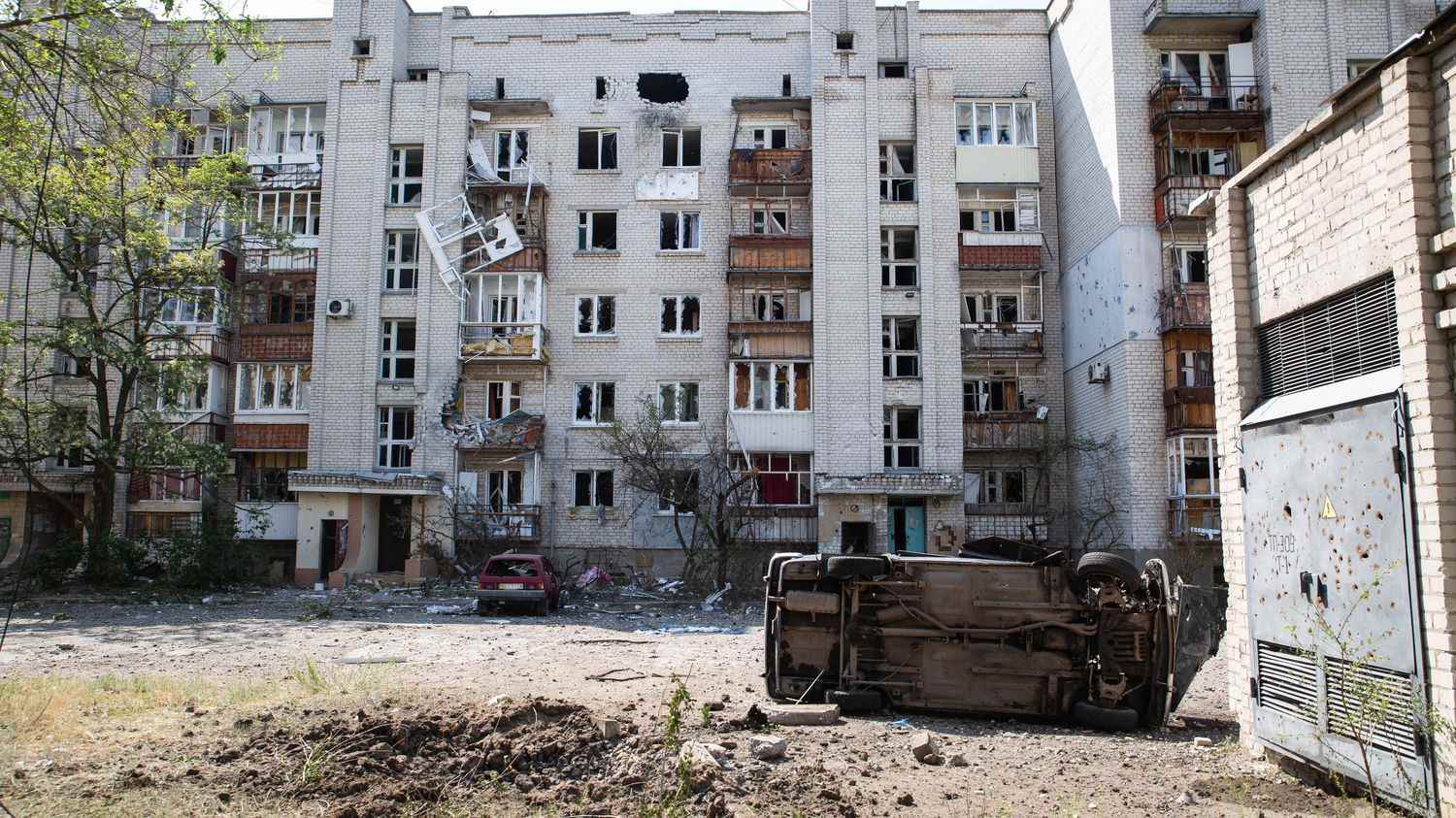“It’s a ghost town.” The locality of Sievierodonetsk is at the heart of very high intensity clashes between Russian and Ukrainian forces. Henry Camenen, co-founder of the NGO Road to Relief, talks about a situation “post-apocalyptic”, depicting destroyed and deserted streets pounded by repeated shelling. President Volodymyr Zelensky has conceded the loss of 80% of this Donbass city, which has become the administrative capital of Luhansk Oblast since the seizure of the eponymous city by the separatists in 2014.
>> War in Ukraine: follow the situation on the front in our live
Ambulances, tanks, gutted cars … The road leading to the city offers a spectacle of desolation, testifies a France 2 team who went there. “It is now impossible to announce a possible humanitarian convoy or an evacuation of civilians on this route”declares the military governor Sergei Gaïdaï.
“There has been no connection in the city for weeks, so when we arrive sometimes people have already left or are dead”, explains Henry Camenen, who is still trying to get to the humanitarian center and the city hospital, under escort of the Ukrainian police. There would only be 6,000 to 12,000 inhabitants left in Sievierodonetskcompared to more than 100,000 before the war.
“We’ve had to go from bombing to bombing before trying to get people back from buildings that had just been hit.”
Henry Camenen, founder of the NGO Road to Reliefat franceinfo
On the spot, the last civilians welcome the Russian army, according to testimonies collected by France 2. “They are not in favor of evacuations by foreign organizations. They are rather favorable to Russia and tell us that they are waiting for the release of the Russians”, confirms Henry Camenen. Difficult, therefore, to convince them to evacuate.
However, the danger is imminent. While the city is more than 90% destroyed, a tank of nitric acid from a chemical plant has been “hit” Tuesday by a Russian strike, according to local authorities. The pro-Russian separatists, for their part, indicated that a container with nitric acid had “exploded” in the Azot factory in Sievierodonetsk. Evidenced by this impressive plume of orange smoke.

It’s here that “the enemy has concentrated most of his efforts and his troops most prepared for combat”, explained a senior Ukrainian military official. The Ukrainian military governor, Sergei Gaïdaï, mentions the presence of 25 tactical groups of Russian battalions, which represents more than 10,000 soldiers.
Submerged, the Ukrainian army massively uses artillery rather than infantry, explains Petro Kuzyk, commander of the Svoboda battalion, quoted by the Ukrainian media. Their enemies are also pounding the area, although urban fighting is also raging as the Russian army invades the city. “From the moment the enemy’s combat posts are neutralized, this will allow the offensive of our fighters on the ground”explains a separatist fighter to France 2.

On Telegram, Sergei Gaïdaï explained Thursday that the Russian forces continued to carry out the assaults and that thirteen attacks had been repelled in the last twenty-four hours. In order to circumvent the Ukrainian resistance, the Russian army launched a major operation, about forty kilometers to the south, with tanks, Grad missile batteries and helicopter gunships. This offensive aims to cut Ukrainian supply lines and asphyxiate the region of Lyssystchansk and Sievierodonetsk. Enough to raise the specter of an encirclement, as in Mariupol.
Another Russian offensive led from the south, around Toshkiva, would aim to open the road to Lyssytchansk without having to fight on the Siversky Donets river which separates it from Sievierdonetsk, underlines the Institute for the Study of War (in English). One of the bridges between the two cities was destroyed and the group of researchers recalls that the Russian army had already suffered a disappointment while trying to cross this river in the past.

President Volodymyr Zelensky said last week that Ukraine was losing 50 to 100 soldiers a day in the region. The Ukrainian army is now in great difficulty, especially since anti-tank missiles are running out. “The Russians have artillery, armored vehicles and their forces are five to six times larger”summarizes a sergeant met by RFI in Lyssytchansk. “Our superiors don’t know where we are or what we are doing.” kyiv is now faced with a dilemma: declare an evacuation order for its troops, in order to avoid a tragic encirclement, or offer resistance to the Russian advance at all costs.
“The enemy has an operational advantage in terms of artillery”, conceded the Commander-in-Chief of the Ukrainian Armed Forces, Valeri Zaloujny, during a telephone conversation with the French Chief of Staff of the Armed Forces, General Thierry Burkhard. In this context, the Ukrainian authorities are calling for an acceleration of deliveries of heavy weapons promised by Western countries, and in particular of American multiple missile launcher systems. Unless it is already too late to reverse the trend in the Luhansk region, and more broadly in the Donbass.
